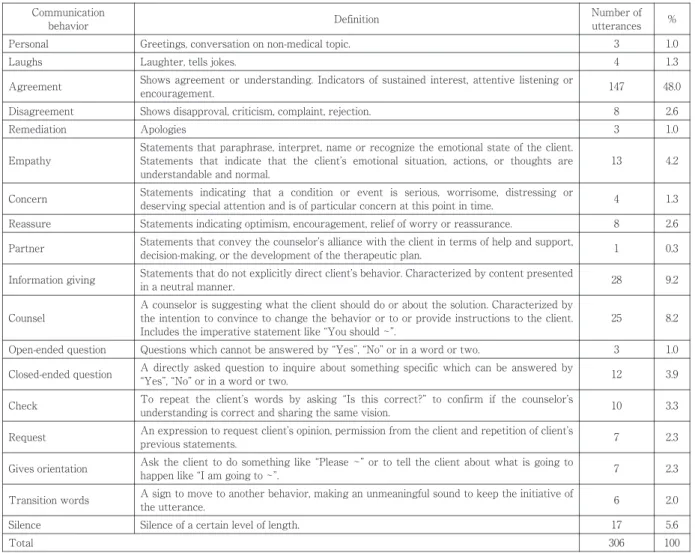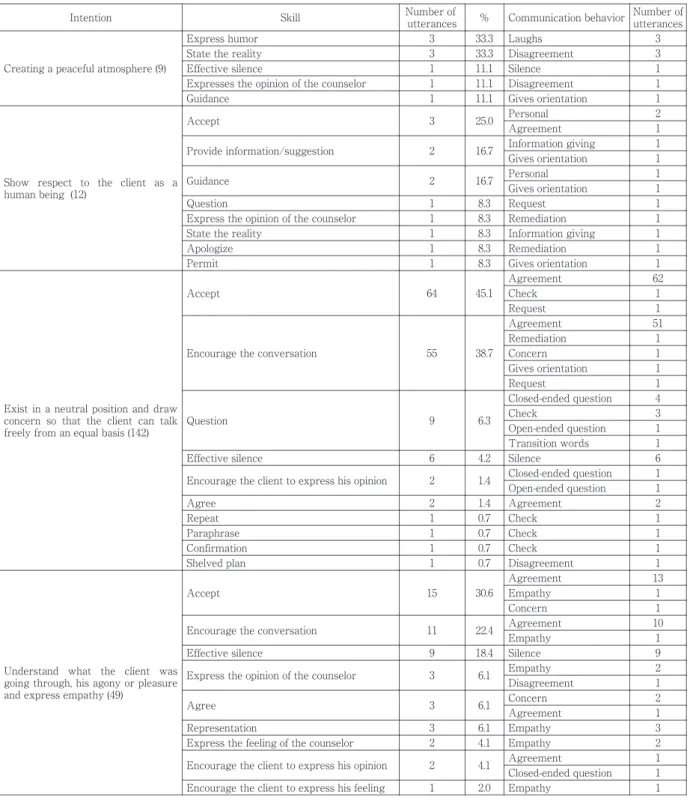Therelationofintention,skillandcommunicationbehavior
ofanexperiencedcounselorinpsychiatricnursingcounseling
-Targetingthecounselingofadepressiveclient-
精神科看護カウンセリングにおける、意図、技法そして態度の関連
-うつ状態の患者への対応-
MasashiKAWANO
1),IkukoNORO
2)川野 雅資・野呂 幾久子
Abst
r
act
Thepurposeofthisstudywastoexploretherelationamongintention,skillandcommunicationbehaviorof anexperiencedpsychiatricnursingcounselorinthecounselingofadepressiveclient.A videotapeofthe counselingwasrecordedandthedialogueofthecounselorwasclassifiedtocommunicationbehavior,skilland intention.Inthecounseling,thecounselorcreatedatrustrelationusingtheintention“Existinaneutralposition anddraw concernsothattheclientcantalkfreelyfrom anequalbasis”or“Understandwhattheclientwas goingthrough,hisagonyorpleasureandexpressempathy”byusingtheskillof{Accept}whichwasexpressed bythecommunicationbehaviorof[Agreement].OnceitwasfoundoutthatMr.A wasinacriticalsituationin theconversationintendedto“Diagnosethemedicalcondition”,thecounselor“Expressedhisopinion”thatthe clientshould behospitalized immediately by theskillof{Expresstheopinion ofthecounselor}with the communicationbehaviorof[Informationgiving]or[Counsel].Thenthecounselor“Assistedtheclient”totake thenecessaryprocessforhospitalization,aswellastochangetheperceptiveoftheclientthatitwasnotdueto him butthemanager.Otherrelationswerealsoseenwherethecounselorachievedintentionsbyusingseveral skillsandtheskillswereexpressedbyseveralkindsofcommunicationbehaviors.
Otherrelationswerealsoseenwherethecounselorachievedmanyintentionsbyusingseveralskillsandthe skillswereexpressedbyseveralcommunicationbehaviors.Thisisactuallywhatthecounselorsaredoingin theircounselingthoughitwouldhavesignificanceinunderstandingwhataneffectivecounselingwouldbeby sortingoutandreviewingthroughanobjectivemethod.
Keywords:intention,skill,communicationbehavior,RIAS,depressiveclient
Ⅰ I
nt
r
oduct
i
on
Thegoalofcounselinginpsychiatricnursingisthat“theclientshouldfeeltrustandasenseofsecurityabout hiscounseloranddeveloparelationshiptobeabletotalkabouthis/heranxiety,concernanddistresswithout
thefearofrejection”1) and“toreducethepainoftheclientandtosupporttobeabletoadvancepersonal
relationshipandparticipateincivillife”1).Whileconsideringtheclient’soccasionalconditionsandfeelings,the
counselorwillfaceclientsineachsituationwiththe“intention”tomeethis/hergoaleventually.Forexample,if aclientwouldsaythathewouldliketodisappearthecounselorwouldinitiateaconversationtofindoutinhow muchseriousconditiontheclientisin.Inthissituation,theintentionoftheconversationistodiagnosethe medicalcondition.Detailis needed to diagnose the medicalcondition thus the counselor may retrieve informationbyusinga“skill”toaskquestion,suchas“Whywouldyouthinklikethat?”.Theskillchosenbythe counselorisproducedasa“communicationbehavior”.Forexample,thecommunicationbehavior“Whywould you think likethat?”iscalled “open-ended question”which isan unstructured question in which possible answersarenotsuggested.Thus,theconversationofacounselorinpsychiatricnursingcounselingconsistsof threeelementswhichareintention,skillandcommunicationbehavior.Whendiagnosingtheclient’smedical condition asin the above example,however,one may use the skillto draw outfurtherinformation by encouragingtheconversation(e.g.“Pleaseproceed.”)besideofaskingaquestion.Thereisalsoachancethatthe communicationbehaviorisusedastheconfirmationaboutwhattheclienthasalreadymentioned,namely“You wouldliketodisappear,isthatwhatyouaresaying?”.Theremaybevariouskindsofrelationofintention,skill and communication behavior.Itisbelieved thatan experienced psychiatricnursing counselorknowsthe relationswellandiscapabletousethethreeelementsinafreeandeffectivemannerduringcounseling.But therehasbeen nostudy reported which would explain abouttherelationsofthosethreeelementsin a structuredwaysofar.Toshedlighttotherelationamongintention,skillandcommunicationbehaviorwould revealthestructureofaneffectiveconversationofanexperiencedpsychiatricnursingcounselorandmay provideabasicdatatotheless-experienced.
Based on this perspective,Noro et al(2015)2) analyzed the counseling for a client suffering from
schizophreniatofindouttherelationsbetweenintentionandskillaswellastherelationsbetweenskilland communicationbehavior.Inthisstudy,afurtherstudywasmadeaboutthecounselingforadepressiveclient byanexperiencednursingcounselortoexaminetherelationamongintentionskillandcommunicationbehavior.
Ⅱ Met
hod
1 Subjectandsituation
A videotapeofacounselingrecordedonMay2014wasanalyzedwhichlastsforabout57minutes.The counselorisamaleinhissixtieswhoreceivedhisprofessionaleducationinagraduateschoolandhasmore than30yearsofexperienceinthedepartmentofpsychiatricnursing.Theclient(Mr.A)isamaleinhisfifties wholivesinhishouseandattendsthecounselingonaperiodicbasis.
Thescenesconsistofthefollowingsituations:Mr.A whotookatemporaryleavefordepressionandjust returnedtoworkisafraidofhismanagerwhoisconstantlyrunningMr.A down.Mr.A feelsthathedoesn’tfit inthecompanyandfightsagainsttheconflictthathemightlosehisjobifhewouldtakealeavenexttime
1)NaragakuenUniversity
whichwouldcausetroubletohisfamily.Feelingsorryforhisfamilyandfeelingguiltyabouthisworthlessness makeshim looseconfidenceabouthimselfandstartstothinkaboutself-destruction.Inthecounseling,the counselorislistening toMr.A carefully tounderstand Mr.A’spain and recommendstoreceivehospital treatmentandtobehospitalized.
2 Procedures
The study protocolwas reviewed and approved by the InstitutionalReview Board ofSanyogakuen University.Theproceduresofthisstudyareasfollows;1)dividethedialogueofcounselorintoasmallunitand classifyeachunitintocommunicationbehavior,2)classifyeachunitintoskill,3)classifyeachunitintointention, 4)countthenumberofunitsineachcommunicationbehavior,skillandintention,5)examinetherelationsofthe threeelementsbyprovidinganexample.
1)Classificationofthecommunicationbehavior
NoroclassifiedthecommunicationbehaviorwhilereferringtoRoterInteractionAnalysisSystem (RIAS)3).
RIASisacodingsystem themostworldwidelyusedtocodethecommunicationbehaviorofmedicalvisit.The feasibility and validity ofapplying theRIAS toJapanesemedicalconversationshasbeen investigated and confirmedbyIshikawaetal4).TheRIASunitofanalysisiscalled“utterance”,acompletethoughtdefinedas
thesmallestdiscriminablespeechsegmenttowhichacodeclassificationmaybeassigned3).Codesaremutually
exclusiveandexhaustivesothateveryexpressedthoughtisassignedtoonlyonecategorythatreflectsthe communicationbehavior.
2)Classificationofskill
Kawanoclassified each utteranceofthecounselorby referencing thetherapeuticcommunication skills1)
underskill.Therapeuticcommunication skillsdonotspecify aboutthedefinition ofeach skillthusitwas definedbyKawanobasedonthestudyofNoroetal(2015)2).Whenaskillappeared,whichdidnotappearin
thestudyofNoroetal(2015)2),itwasdefinedbyKawanoandaddedasanew one.
3)Classificationofintention
Again,Kawanowhohasperformedthecounselinggroupedeachutteranceofthecounselorbyreviewingthe intention.KawanohasgroupedanddefinedtheintentionbasedonNoroetal(2015)2)andcametoaconclusion
byreviewingwithKawano.Whenanew intentionwasfoundinthiscounseling,Kawanodefineditandaddedit asanew one.
Ⅲ Resul
tandDi
scussi
on
1 Communicationbehaviorofthecounselorduringthecounseling
The totalnumberofutterance made by the counselorwas306.Table 1 indicatesthe communication behavior,the definition,numberofutterances,and percentage to the totalnumberofutterancesofthe
counselorinthiscounseling.
“Agreement”isthemostseenwhichcoversalmostthehalfwith147utterances(48%).Itisanutteranceto indicatethatthecounselorislistening,agreeingorunderstandingMr.A’stalk.Itcanbeconcludedthatthe counselorwasindicating alotofutterancestolisten and accepttheMr.A’sagony.“Information giving” covered9.2% whenputtingtogetherwith“Counsel”wherebothcontentscovered17.4% inthiscounseling.This canbeconcludedfrom thefactthatthecounselingscenesconsistedofMr.A inasurvivalsituationwherethe counselorhadtoinform thecurrentsituationorsolutionandtherewasaneedtoadviseMr.A abouttheway ofacting.
2 Theskillusedduringthecounselingbythecounselor
Next,skillsusedinthisstudyincludingthedefinition,numberofutterancesandthepercentagetothetotal numberofutterancesareshowninTable2.
% Numberof utterances Definition Communication behavior 1.0 3
Greetings,conversationonnon-medicaltopic. Personal 1.3 4 Laughter,tellsjokes. Laughs 48.0 147
Showsagreementorunderstanding.Indicatorsofsustainedinterest,attentivelisteningor encouragement.
Agreement
2.6 8
Showsdisapproval,criticism,complaint,rejection. Disagreement 1.0 3 Apologies Remediation 4.2 13
Statementsthatparaphrase,interpret,nameorrecognizetheemotionalstateoftheclient. Statementsthatindicatethattheclient’semotionalsituation,actions,orthoughtsare understandableandnormal.
Empathy
1.3 4
Statementsindicating thata condition oreventisserious,worrisome,distressing or deservingspecialattentionandisofparticularconcernatthispointintime.
Concern
2.6 8
Statementsindicatingoptimism,encouragement,reliefofworryorreassurance. Reassure
0.3 1
Statementsthatconveythecounselor’salliancewiththeclientintermsofhelpandsupport, decision-making,orthedevelopmentofthetherapeuticplan.
Partner
9.2 28
Statementsthatdonotexplicitlydirectclient’sbehavior.Characterizedbycontentpresented inaneutralmanner.
Informationgiving
8.2 25
A counselorissuggestingwhattheclientshoulddooraboutthesolution.Characterizedby theintentiontoconvincetochangethebehaviorortoorprovideinstructionstotheclient. Includestheimperativestatementlike“Youshould~”.
Counsel
1.0 3
Questionswhichcannotbeansweredby“Yes”,“No”orinawordortwo. Open-endedquestion
3.9 12
A directlyaskedquestiontoinquireaboutsomethingspecificwhichcanbeansweredby “Yes”,“No”orinawordortwo.
Closed-endedquestion
3.3 10
Torepeattheclient’swordsbyasking“Isthiscorrect?”toconfirm ifthecounselor’s understandingiscorrectandsharingthesamevision.
Check
2.3 7
Anexpressiontorequestclient’sopinion,permissionfrom theclientandrepetitionofclient’s previousstatements.
Request
2.3 7
Asktheclienttodosomethinglike“Please~”ortotelltheclientaboutwhatisgoingto happenlike“Iam goingto~”.
Givesorientation
2.0 6
A signtomovetoanotherbehavior,makinganunmeaningfulsoundtokeeptheinitiativeof theutterance.
Transitionwords
5.6 17
Silenceofacertainleveloflength. Silence
100 306
Total
Table1 Communicationbehaviorsofthecounselorduringthecounseling
% Numberof utterances Definition Skill 3.6 11
Questionsinanopenorclosedwayusingwordstomakeiteasyfortheclienttotalk. Question
The skillof“Accept”wasthe mostused with 84 utterances(27.5%)and followed by “Encourage the conversation”(21.6%).Usingthoseskills,thecounselorwassendingamessagetoMr.A thatheislisteningand acceptingandwouldliketoproceedwiththeconversation.Ontheonehand,thecounselorwasexpressinghis opinionaboutMr.A’ssituationusingthe“Expresstheopinionofthecounselor”skill(10.8%).Thecounselor providedasolutiontoMr.A usingthe“Provideinformation/suggestion”skill(9.5%).
3 Theintentionofthecounselorduringthecounseling
Table3indicatestheintention,thedefinition,numberofutteranceandthepercentageoftheutterancetothe total.
27.5 84
Expressempathytotheclientthatthecounselorislisteningtowhatwassaidand whatwassaidhasavalidpoint.
Accept
21.6 66
Expressverbal/non-verbalmessagestomaketheclienteasiertotalk. Encouragetheconversation
5.6 17
Arrangesomeutterancefortheclienttotalkabouthisfeeling.Expresstheintention ofthecounselorthatthereisnoneedforaconversationorshowtheimportanceofthe utterancespendingtogether.
Effectivesilence
0.3 1
Questiontheclienttoexpresshisfeeling.Thecounselormaymurmurthefeelingof theclientbyengaginginself-questioning.
Encouragetheclienttoexpress hisfeeling
4.9 15
Questiontheclienttoexpresshisopinion.Thecounselormaymurmurhisopinionof theclientbyengaginginself-questioning.
Encouragetheclienttoexpress hisopinion
1.0 3
Counselorexpressesthefeelingwhenhereactedtotheclient'sexperience. Express the feeling of the
counselor
10.8 33
Counselorexpressestheopinionabouttheclient'sexperience. Express the opinion of the
counselor
1.0 3
Expressinwordsaboutthegoodpoints(opinion,behavior,characteretc.)ormaking efforts.
Tellthegoodpoints
1.0 3
Expressthegruelingexperienceoftheclientasajokeorturnitintoasmile. Expresshumor
5.9 18
Talkaboutwhatiscurrentlygoingonandwhatneedstobedonenow. Statethereality
9.5 29
Thecounselorinformsaboutwhatisnecessary totheclientand statesseveral solutionsornecessarymeasures
Provideinformation/suggestion
2.6 8
Thecounseloragreestotheclient'sopinion,behaviororaction. Agree
1.3 4
Thecounselorinownwordslooksfrom theclient'spointofpositionandview to expresswhattheclienthasn'tmentionedyet.
Representation
1.0 3
Thecounselorleadsandtalksfortheeaseoftheclient'saction. Guidance
0.7 2
Repeatwhattheclienthasexpressedusingsamewords. Repeat
0.7 2
Asktheclientaboutthecounselor'sunderstandingtobeappropriateornot. Confirmation
0.3 1
Useanotherwordwiththesamemeaningtoexpresswhattheclienthasmentioned. Paraphrase
0.3 1
Expressthecounselor'smistake,errororfailureinadirectfashion. Apologize
0.3 1
Thecounselorisaskingtheclientforpermissionabouttheactionheisabouttotaketo beappropriateornot.
Permit
0.3 1
Thecounseloronceacceptswhenaclientasksforanadviceorimplicateabouthis thoughts,opinionsoractions.Inthatcase,thetopicwon'tbedealtfornow andthe focuswillbeshiftedtoanothertopic.
Shelvedplan 100 306 Total % Numberof utterances Definition(Goaloftheintention,theexistentialreason,idea,result,aim,contentetc.)
Intention
2.9 9
Toorganizeaspaceoftherapyandcomfortfortheclienttorealize.Tocreateapeaceful moodandtoreturntonormalone'sself,i.e.relaxationoftension,ahumortogetintune, haveacomfortabletalkandcreateanatmosphere.
Creating a peaceful atmosphere
3.9 12
Show theheartofhospitalityaswellashow muchimportant,valuablehumanbeingthe clientisandtreathim assuch.Thisistoincreasethesenseofself-respectoftheclient.In particular,expressviaverbal/non-verbalmeans,goodsandenvironmentthattheclientis animportantexistenceasahumanbeing.
Show respecttotheclient asahumanbeing
Themostseenintentionthecounselorusedwas“Existinaneutralpositionanddraw concernsothatthe clientcantalkfreelyfrom anequalbasis”whichwasalmostthehalfthetotal(46.4%).Secondly“Understand whattheclientwasgoing through,hisagony orpleasureand expressempathy (16.0%).Taking thisinto consideration,itcanbeconcludedthatmorethan60% oftheutteranceswereconsumedbythecounselorto acceptandlistentoMr.A withoutcriticism,relivehisagonyandexpressthefeelingwhichweregeneratedin thatcounseling.Inadditiontothealreadyestablishedtrustfrom Mr.A tothecounselorasin“Ithoughtthat youneverwouldcriticizemelikethat.”or“Iwastryinghardtocarryonlivingtomeetyoutoday,justlike that.”,itissuchkindofattitudeofthecounselorwhichembracedthecomfort,trustandbondtobeacceptedto encourageMr.A tospeakatitsowninitiative.
46.4 142
Uncriticallyreacttotheclient'sagonyinaseriousmanner.Oncetheclientexpresseshis feeling willactas a catalystofchange to his preference,fixation or obsession. Additionally,theclientwillhaveakeendesiretotrustthecounselorwhichleadstoa feelingofsecurity.Inparticular,communicatetotheclientinbothaverbalandnon-verbal mannerthateverysingleexperienceismeaningfulandhasitsvaluetopreventtheclient from stoptalking.Thecounselorshouldlistencarefullytotheclient'sexperienceand respondbybody-language,theninquirefurtherabouttheclient'sexperiencetobeableto expressabouttheaffectionofit.Itisimportanttoindicateviaverbally/non-verbally meansthattheclientwasabletomakehispointtothecounselorfreely.
Existin a neutralposition and draw concern so that theclientcantalkfreelyon anequalbasis
16.0 49
Relivetheexperienceoftheclient,expressthefeelingofthecounselor.Thisistobecome emotionallyaccessiblewiththecounselorbysharingtheirexperienceandtofreethem up from desolationandbecomeobjectiveaboutthesituation.Inparticular,theclientwill explainabouthisownexperiencetothegroundsothatthecounselorwillbeabletorelive theirexperience(i.e.asitwasexperienceddirectlybythecounselor).Thecounselorthen willexpresstheirfeelingatthatpoint.Inanswertotheclient'sexperience,thecounselor willexpresshisfeeling.
Understandwhattheclient was going through, his agony or pleasure and expressempathy
3.3 10
Toavoidsituationslikeescapeofmemory,incomprehensibility,suspicionandanxiety,the counselorneedstoprovideinformationandexplainabouthisideaandbehaviorabout whatactionsaclientneedstotakeinacomprehensiblemanner.Ifnecessary,itis recommendedtotakenotes.Toassistclientstotakenotesoruseelectronicdevicesto avoidescapeofmemoryorconfusion.Motivationofactionisrecommendedifnecessary. Shakeoffanxiety
6.2 19
Thecounselormustunderstandthecondition/medicalconditionsothattheclientisable tounderstandhiscondition/medicalcondition.Inparticular,questionasanexpertto assess,ifnecessarytoexplaintheresultsviawordsorgraphicdisplaysothattheclient canunderstand.
Diagnose medicalcondition andstateittotheclient
14.4 44
Wouldopenuptothinkobjectivelyabouttheabnormalexperiencewhenpointedout.In consequence,the reaction to the medicalcondition would change.The clientwill understandthatamedicaltreatmentismandatoryjustasmuchascounselingwiththe primarydoctor.Inprimary,thecounselorshouldexpresshisdecisionandopiniondirectly. Sometimes,itmaybenecessarytopointoutabouttheabnormalexperienceoftheclient. Expresstheopinion ofthe
counselor,commentandjust argument
6.2 19
Understand,expressunderstandingorproposetheclient'slivingconditionandopinion. Affirm andmotivate,encourageandbackupsothattheclientwouldfurthermorechange hisbehavior.Substantiate resolution behavior,think together.Help to change the viewpointand way ofthinking.Question abouttheclient'slife,behavior,reason of behaviorandanxiety.Checktheclient'sbehavior.Thisistoencouragethechangeof cognitionandbehaviorandtogainproblem-solvingthoughtsandbehavior.Thiswilllet theclientthinkobjectively,remindtodoallkindofthinkingandchangetheissueinlife.In particular,itindicatesthedecisionofthecounseloraboutthegoodwayofthinking, behavior,changeorcopingprocessoftheclientinanexplicit,inaclearandsometimes stronglyemphasizedasverygoodway.Askingquestionsindetailandwhentheclientis talkingabouthislifeinparticulardetail(narrative)thecounselorwillexpressina verbal/non-verbalmannerthathehasunderstoodwhatwastold.Bythinkingtogether aboutasolution,thecounselorwillprovideanopinionsothattheclienthasachanceto choosewhichsolutiontoselect.Reachouttocognitiontopresentthatthereareother waysofthinking,pointofviews.Sometimes,itmaybenecessarytoquestionwhythe clientunderstoodthesituationthatwayandtoillustratethatthereareothermeanings. Thecounselorneedstocreateanenvironmentandquestiontheclientinaverbal /non-verbalmannersothattheclientcanfreelytalkandthatthereisnoneedtoconcealhis opinion.Questiontheclientinawaysothathecantellabouthisbehaviorindetail. Assistthe client's opinion,
behavior,changeorcoping processandencouragehim togetbettersoon
0.7 2
Nospecialmeaningswhichwereexpressedbytheflowofabehaviororconversationina spontaneouswayasaTransitionwordssound.Asocialresponse.
Other
100 306
Undersuchrelationship,thecounselorsteppedintofortreatment.Itwasjudgedthatthiswasacritical situationwhereMr.A wouldcommitsuicidethusitservedtoconsidertheunderstandingofMr.A (Intention “Diagnosemedicalconditionandstateittotheclient”(6.2%)).ItwasthencommunicatedimmediatelytoMr.A tobehospitalized(Intention“Expresstheopinionofthecounselor”(14.4%)).
4 Relationofintention,skillandcommunicationbehavior
Therelationofintention,skillandcommunicationbehaviorissummarizedasintable4.
Numberof utterances Communicationbehavior
% Numberof utterances Skill Intention 3 Laughs 33.3 3 Expresshumor Creatingapeacefulatmosphere(9)
3 Disagreement 33.3 3 Statethereality 1 Silence 11.1 1
Effectivesilence
1 Disagreement 11.1 1 Expressestheopinionofthecounselor 1 Givesorientation 11.1 1 Guidance 2 Personal 25.0 3 Accept
Show respect to the client as a humanbeing (12)
1 Agreement
1 Informationgiving
16.7 2
Provideinformation/suggestion
1 Givesorientation 1 Personal 16.7 2 Guidance 1 Givesorientation 1 Request 8.3 1 Question 1 Remediation 8.3 1 Expresstheopinionofthecounselor 1 Informationgiving
8.3 1 Statethereality 1 Remediation 8.3 1 Apologize 1 Givesorientation 8.3 1 Permit 62 Agreement 45.1 64 Accept
Existinaneutralpositionanddraw concernsothattheclientcantalk freelyfrom anequalbasis(142)
1 Check 1 Request 51 Agreement 38.7 55 Encouragetheconversation 1 Remediation 1 Concern 1 Givesorientation 1 Request 4 Closed-endedquestion 6.3 9 Question Check 3 1 Open-endedquestion 1 Transitionwords 6 Silence 4.2 6
Effectivesilence
1 Closed-endedquestion 1.4
2 Encouragetheclienttoexpresshisopinion
1 Open-endedquestion 2 Agreement 1.4 2 Agree 1 Check 0.7 1 Repeat 1 Check 0.7 1 Paraphrase 1 Check 0.7 1 Confirmation 1 Disagreement 0.7 1 Shelvedplan 13 Agreement 30.6 15 Accept
Understand what the client was goingthrough,hisagonyorpleasure andexpressempathy(49) 1 Empathy 1 Concern 10 Agreement 22.4 11 Encouragetheconversation 1 Empathy 9 Silence 18.4 9
Effectivesilence
2 Empathy 6.1 3 Expresstheopinionofthecounselor 1 Disagreement 2 Concern 6.1 3 Agree 1 Agreement 3 Empathy 6.1 3 Representation 2 Empathy 4.1 2
Expressthefeelingofthecounselor
1 Agreement
4.1 2
Encouragetheclienttoexpresshisopinion
1 Closed-endedquestion 1 Empathy 2.0 1
Encouragetheclienttoexpresshisfeeling
Wearenow goingthrougheachintentiontoexaminetherelationwiththeskillandthecommunication behaviorby providing an example.In theexamples,theskillsaresurrounded by {},thecommunication behaviorby[].(Example:{Expresshumor}-[Laughs]indicatesthattheskillof{Expresshumor}isexpressedby thecommunicationbehavior[Laughs])
1)Existinaneutralpositionanddraw concernsothattheclientcantalkfreelyfrom anequalbasis Themostseenskillofthisintentionwas{Accept}whichindicatesthatthecounselorwaslisteningoroffered
5 Informationgiving
60.0 6
Provideinformation/suggestion Shakeoffanxiety(10)
1 Reassure 1 Reassure 20.0 2
Expresstheopinionofthecounselor Counsel 1 1 Reassure 10.0 1 Statethereality 1 Reassure 10.0 1 Agree 4 Informationgiving
42.1 8
Provideinformation/suggestion
Diagnosemedicalconditionandstate ittotheclient(19) 4 Counsel 2 Counsel 36.8 7
Encouragetheclienttoexpresshisopinion
2 Transitionwords 1 Open-endedquestion 1 Closed-endedquestion 1 Request 2 Counsel 10.5 2 Expresstheopinionofthecounselor 1 Agreement 5.3 1 Accept 1 Empathy 5.3 1 Representation 10 Counsel 52.3 23 Expresstheopinionofthecounselor
Expresstheopinionofthecounselor, commentandjustargument(44)
7 Informationgiving
2 Empathy 1 Disagreement 1 Reassure 1 Partner 1 Givesorientation 4 Informationgiving
20.5 9
Provideinformation/suggestion CounselTransitionwords 22 1 Check
3 Informationgiving
15.9 7 Statethereality 1 Agreement 1 Disagreement 1 Check 1 Transitionwords 3 Reassure 6.8 3 Tellthegoodpoints 1 Closed-endedquestion 2.3 1 Confirmation 1 Check 2.3 1 Repeat 1 Laughs 26.3 5 Statethereality
Assisttheclient'sopinion,behavior, change or coping process and encouragehim togetbettersoon(19)
1 Agreement
1 Informationgiving
1 Closed-endedquestion
1 Counsel
2 Informationgiving
21.1 4
Provideinformation/suggestion Counsel 1 1 Givesorientation 2 Closed-endedquestion 15.8 3
Encouragetheclienttoexpresshisopinion Request 1 2 Counsel 10.5 2 Expresstheopinionofthecounselor 2 Agreement 10.5 2 Agree 1 Agreement 5.3 1 Accept 1 Closed-endedquestion 5.3 1 Question 1 Silence 5.3 1
Effectivesilence
1 Request
50.0 1
Encouragetheclienttoexpresshisopinion
Other(2) Statethereality 1 50.0 Request 1
thumbsupaboutwhatMr.A hasmentioned(64utterances,45.1%).Secondly{Encouragetheconversation}via verbalornon-verbalmessagesothatMr.A couldfinditeasytoexpresshimself(55utterances,38.7%)followed by {Question}wherethecounselorasked aquestion (9utterances,6.3%).Mostoftheskillsof{Accept}or {Encouragetheconversation}wereexpressedbythecommunicationbehaviorof[Agreement],statementsto show agreementorunderstandofwhatMr.A hasmentionedorviaasupportiveresponse.
The<Example1>indicatesthebeginningofthecounseling.ThecounselorwastoldoverthephonebyMr. A thathewashavingdifficultiesatthecompanywhenreturnedwherehesufferedfrom adepressionandhad totakealeaveofabsencefrom hisjob.Tocollectextensiveamountsofinformation,thecounselorasked questionsbyusingthecommunicationbehaviorof[Open-endedquestion]tomakeiteasierforMr.A totalk aboutthis.Afterthat,thecounselorencouragedMr.A totalkandexpressedthathehasacceptedthefeeling ofMr.A by[Agreement].
<Example1>
Ns:Yourstartdaywasonthe7thandhow iseverythinggoingsincethen? {Question}-[Open-endedquestion] Cl:Well,(3secondsofsilence)Isomehow knew itwillendupthisway(Takingadeepbreath)
Ns:Yah{Encouragetheconversation}-[Agreement]
Cl:It’slikeeverythingisfallingapart(10secondsofsilence) Ns:Hmm.{Accept}-[Agreement]
Otherthanthe[Open-endedquestion],theskillof{Question}wasexpressed4timesin[Closed-endedquestion] where a question wasasked which could be answered by justa “yes”or“no”to retrieve a particular informationfrom Mr.A,and3timesbythecommunicationbehaviorof[Check]torepeatwhatMr.A has mentionedandtoconfirm ifthecounselor’sunderstandingwascorrectornot.<Example2and3>indicatesthe serious-minded approach of the counselor to listen to Mr.A’s story by asking questions using the communicationbehaviorof[Closed-endedquestion]or[Check].
<Example2>
Ns:(Eachandeveryday,Mr.A wasfacedwithcriticism bythewordsofthemanager:“Youbetterbethe factoryheadifyouwanttokeepyourcurrentsalary”,towhichthecounselorresponds)Mr.A,whendoes yourmanagersaysuchathing?{Question}-[Closed-endedquestion]
<Example3>
Ns:(ThecounselorreactingtowhatMr.A toldaboutwhathismanagerhadmentioned:“Mr.A’sconditiongot evenworsebecauseofanindulgentcounselor”) Didhereallysaythat?{Question}-[Check]
2)Understandwhattheclientwasgoingthrough,hisagonyorpleasureandexpressempathy
{Encouragetheconversation}(11utterances,22.4%)buttheskillof{Effectivesilence}wasusedmostamongall intentiontoprovidetimeforMr.A tothink(9utterances,18.4%).Mostoftheskillsof{Accept}and{Encourage theconversation}wasexpressedby[Agreement]justliketheintentionin1).
<Example4>isthescenewhereMr.A wasexpressinghisguiltbecausehereturnedtoworkbutcouldn’t doanything and causing troubletoothers.By thecommunication behaviorof[Agreement],thecounselor encouragedtotalkandmentionedthathehasacceptedhisagonyonceMr.A hascompletedhisconversation. By inserting an intervalof18seconds,thecounselorshowed an attitudetowaituntilMr.A hasspoken everythingwhatwasonhismind.
<Example4>
Cl:Idon’twantto(sobbing),wanttoputthecompany,myfamilyandyou(2secondsofsilence)toanymore trouble(10secondsofsilence),Ifeelsohelpless(sobbing).
Ns:Yah{Encouragetheconversation}-[Agreement] Ns:(18secondsofsilence){Effectivesilence}-[Silence]
Cl:Iam aware(sobbing)(4secondsofsilence)thatIam givingeveryoneagooddealoftrouble(3secondsof silence)Ifinally(2secondsofsilence)understoodthat.
Ns:Iknow.{Accept}-[Agreement]
Thecommunicationbehaviorof[Empathy]whichshowsempathytoMr.A’sfeelingorshow understanding thatMr.A’sbehaviorisunderstandablewasseen13timesinthiscounseling.10outof13utteranceswereseen in thisintention.<Example5> indicatesthecounselorunderstandsMr.A’sagony and thatheisstaying present.HealsoencouragesMr.A totalkabouthow hefeels.
<Example5>
Ns:Iam reallysorrytohearthat.Youdidverywell.{Expressthefeelingofthecounselor}-[Empathy] Ns:(50secondsofsilence){Effectivesilence}-[Silence]
Ns:WespokeoverthephoneonThursday,didn’twe? {Question}-[Check] Cl:Yes.
Ns:Itmusthavebeenpainfulatthattimeaswell,wasn’tit?{Encouragetheclienttoexpresshisfeeli ng}-[Empathy]
3)Expresstheopinionofthecounselor,commentandjustargument
Theskillof{Expresstheopinionofthecounselor}wherethecounselorexpresseshisopinionaboutMr.A’s experience(23utterances,52.3%)wasseenmostinthisintentionfollowedby{Provideinformation/suggestion} whichprovidesnecessaryinformationtoMr.A orthesolutionprovidedbythecounselor(9utterances,20.5%). TostatehisopiniontoMr.A,thecounselorusedthecommunicationbehaviorof[Counsel]toadviseMr.A whatactionsto take (10 utterances)or[Information giving]to provide information in a neutralway (7
utterances).Also,to provide information or solution,the counselor used the communication behavior of [Informationgiving](4utterances)or[Counsel](2utterances).
In<Example6>,takingMr.A’scurrentmedicalconditionintoconsideration,thecounselorsensedthatthe currentambulanttreatmentistooriskyandMr.A shouldreceivehospitalizationtherapyimmediatelywhere hisopinionwastoldopenlytoMr.A asanadvice.In<Example7>,thenecessarymethodorprocessfor hospitalizationwasproposedtoMr.A asinformation.
<Example6>
Ns:Mr.A,let’sgetanew start(2secondsofsilence){Expresstheopinionofthecounselor}-[Counsel] Ns:...eliminatedepressiontogether(3secondsofsilence){Expresstheopinionofthecounselor}-[Counsel] Ns:andreturntohealth.{Expresstheopinionofthecounselor}-[Counsel]
<Example7>
Ns:YoutoldmethatyouliveintownD sothefirstoptionwouldbetoapplyforanemergencymedical admissionintownD {Provideinformation/suggestion}-[Counsel]
Ns:orifyoucanwaituntiltomorrow IcancallupsomeoneIknow.{Expresstheopinionofthecounsel or}-[Informationgiving]
Ns:Iam notsureaboutthevacanciesofthehospital.{Expresstheopinionofthecounselor}-[Information giving]
Cl:OK.
Ns:IfyoudecidefortownD (3secondsofsilence){Provideinformation/suggestion}-[Transitionwords] Ns:Youcanbehospitalizedforcertain.{Provideinformation/suggestion}-[Informationgiving]
4)Diagnosemedicalconditionandstateittotheclient
Inthisintention,theskillof{Provideinformation/suggestion}(8utterances,42.1%)or{Encouragetheclientto expresshisopinion}(7utterances,36.8%)wasseenalot.{Provideinformation/suggestion}wasexpressedinthe communicationbehaviorof[Informationgiving](4utterances)and[Counsel](4utterances).
In<Example8>,Mr.A wastellingthathewascriticizedbyhismanagereverydayanddidnotwanttobe inthecompanywherehedidnotfitinorathishomewherehewascausingtroublewhichwashuntinghim down.Thecounselorattemptedtoevaluatethemedicalconditionbyusing[Open-endedquestion]toencourage Mr.A totalkmoreabouthisfeelings.Infact,thecounselordrew outthetruthfrom Mr.A thathewas actuallythinkingtocommitasuicide(“IwishIcoulddisappearfrom thisworld”)whichimplieshewasina criticalcondition.In<Example9>,thecounselorinformedMr.A by[Informationgiving]or[Counsel]thathe concludedthatMr.A needshospitalizationtherapyandaskedforhisunderstanding.
<Example8>
question] <Example9>
Ns:Whatyouneedistorest{Provideinformation/suggestion}-[Counsel]
Ns:Iwilltry(bymyself)tofindaplaceforyou.{Provideinformation/suggestion}-[Informationgiving] 5)Assisttheclient’sopinion,behavior,changeorcopingprocessandencouragehim togetbettersoon
Themostseenskillinthisintentionwas{Statethereality}whichbringsupwhatwascurrentlygoingon(5 utterances,26.3%)followedby{Provideinformation/suggestion}(4utterances,21.1%),then{Encouragetheclient toexpresshisopinion}(3utterances,15.8%).
The<Example10>dealsaboutthefinalphaseoftheconversation.ThecounselorwasconcernedthatMr.A mightcommitsuicideonhiswayhomeandadvisedinarealisticmannertoaskMr.A togetataxihome,lent him the money who did nothave enough money.In <Example 11>,the counselor daringly used the communicationbehaviorof[Request]torequestanopinionfrom Mr.A whothoughtthatthemanager’sanger wasbecauseofhisworthlessnesswhichledtolow self-esteem ofMr.A.TosupportMr.A tochangehis perspective,thecounseloradvisedMr.A thatitwasnotduetohim butthemanagerwhowasmisdirectinghis angertoMr.A ratherthantohimself.Andin<Example12>,thecounselorexpressedhisopinionbyusing [Counsel]thatMr.A shouldfocusnotonothersbutonsolvinghisagonytoencouragetodirecthisattentionto theproblem resolution.
<Example10>
Ns:Iwillpayforthefare{Statethereality}-[Counsel] <Example11>
Ns:(withrelationtoMr.A aboutthemanagerfilledwithrage)Doyouhaveanyideawhy?{Encouragethe clienttoexpresshisopinion}-[Request]
Cl:Ihavenoclue.
Ns:Ibelieveitisbecausethemanagerisawarethathemadeamistake.{Expresstheopinionofthecounsel or}-[InformationGiving]
Ns:Theangerusedtobemeanttopointagainsthim buthedoesnotfeelresponsiblethustherageisnow pointedatyou.{Expresstheopinionofthecounselor}-[InformationGiving]
<Example12>
Ns:(Aftermentioningthattherewasnoneedtothinkaboutthesurroundings)Itisyouragony(whatweneed tothinkabout){Expresstheopinionofthecounselor}-[Counsel]
6)Show respecttotheclientasahumanbeing
In thisintention,theskillof{Accept}hasbeen seen most(3utterances,25.0%).In <Example13>,the counselorservedacupofcoffeetoMr.A asasignofwelcomeandexchangedgreetingsbythecommunication behaviorof[Personal])toexpresstheattitudethatMr.A meanssomethingveryimportanttohim.
<Example13>
Cl:Thankyouforthecupofcoffee. Ns:Youarewelcome{Accept}-[Personal] 7)Shakeoffanxiety
Inthisintention,theskillof{Provideinformation/suggestion}wasusedmost(6utterances,60%)withthe communicationbehaviorof[Informationgiving].<Example14> indicatestheconversationjustbeforetheend. Mr.A decidedtoundergohospitalizationtherapy(whichmeanstoleavethecompany)buthadastrongfearto talkaboutitwithhismanager.Thecounselortoldhim thatheisgoingtotalktothemanageronhisbehalfto takeoutfearfrom Mr.A.ForthepeaceofmindofMr.A,thecounseloragreedtonotworryaboutanything bythecommunicationbehaviorof[Reassure]totheresponsetoMr.A whowasaskinghim thathereallydon’t havetoworryaboutanything.
<Example14>
Ns:Iwillcallyoutomorrow {Provideinformation/suggestion}-[Informationgiving] Cl:IsthereanythingIshouldbedoing?
Ns:No{Agree}-[Reassure]
Ns:Allyouhavetodoistostayathomeandrelax{Provideinformation/suggestion}-[Reassure] 8)Creatingapeacefulatmosphere
Despiteofbeingaseriousscenewheretheconceptofsuicidewasrecalled,thecounselorusedtheskillof {Expresshumor}toturnMr.A’sagonyintoajokeorsmile(3utterances,33.3%)inthisintention.Thisskillwas expressedtotallybythecommunicationbehaviorof[Laughs].
<Example15>indicatesasceneaboutthereactionofMr.A’swifeinregardtothecurrentconditionofMr. A.Sofar,Mr.A tookaleaveofabsenceduetodepressiontwice.Heknew thatifhewouldtakeanotherleave, thecompanywouldlethim go.Thoughrightafterhereturnedtowork,hismedicalconditiongotworseand wasnotinastatetokeepworking.ThecounselortoldMr.A whofeltsorryforhiswifethat“Itisnotthefault ofeitherMr.A orhiswifebecausenobodycouldhaveforeseenthatthemedicalconditionwouldtakesucha suddenturntotheworse”.Rightafterthat,thecounselorchuckledfollowedbythesmileofMr.A.Thechuckle ofthecounselorcreated aspacewhereMr.A could feelathomewhich released thetension ofMr.A entrenchedwithagony.
<Example15>
Ns:Thoughasyourwifementioned,nobodyknew thatit(totakealeaveofabsenceforthethirdtime)would comesoonlikethis.{Expresshumor}-[Laughs]
Cl:Chuckle.
Ⅳ Concl
usi
on
Inthisstudy,weaimedtoexploretherelationoftheintention,skillandthecommunicationbehaviorina counselingforadepressiveclientbyawell-trainedcounselorwhospecializesinpsychiatricnursing.Inthe counseling,thecounselorcreatedatrustrelationusingtheintention“Existinaneutralpositionanddraw concernsothattheclientcantalkfreelyfrom anequalbasis”or“Understandwhattheclientwasgoing through,hisagonyorpleasureandexpressempathy”byusingtheskillof{Accept}whichwasexpressedbythe communicationbehaviorof[Agreement].OnceitwasfoundoutthatMr.A wasinacriticalsituationinthe conversationintendedto“Diagnosethemedicalcondition”,thecounselor“Expressedhisopinion”thattheclient should behospitalized assoon aspossibleby theskillof{Expresstheopinion ofthecounselor}with the communicationbehaviorof[Informationgiving]or[Counsel].Thenthecounselor“Assistedtheclient”totake thenecessaryprocessforhospitalization,aswellastochangetheperceptiveoftheclientthatitwasnotdueto him butthemanager.
Otherrelationswerealsoseenwherethecounselorachievedmanyintentionsbyusingseveralskillsandthe skillswereexpressedbyseveralcommunicationbehaviors.Thisisactuallywhatthecounselorsaredoingin theircounselingthoughitwouldhavesignificanceinunderstandingwhataneffectivecounselingwouldbeby sortingoutandreviewingthroughanobjectivemethod.
Additionalstudieswillbeneeded toincreasethenumberofcounseling tosystematizemuch morethe relation and to deepen the conceptofintention and to sortoutthe classification ofintention,skilland communicationbehaviorwheretherearestillalotofduplicatesbeingseen.
Ref
er
ences
1)KawanoM.ClinicalPracticeofPsychiatricNursing.Tokyo:IGAKU-SHOIN.2005.
2)NoroI,KawanoM,ItoK,KatayamaN andSasakiI.Therelationofcommunicationbehavior,skilland intentioninaninterview ofacounselorinpsychiatricnursing-apilotstudybasedonaninterview ona subjectsufferingfrom schizophrenia-.JournalofDiscourseAnalysisStudyinPsychiatricNursing,3,2015, 13-26.
3)RoterDL& LarsonS.TheRoterinteractionanalysissystem (RIAS):utilityandflexibilityforanalysisof medicalinteractions.PatientEducationandCounseling,46,2002,243-251.
4)IshikawaH,TakayamaT,YamazakiY,SekiY & KatsumataN.Physician-clientcommunicationandclient satisfactioninJapanesecancerconsultation.SocialScienceandMedicine,55,2002,301-311.


